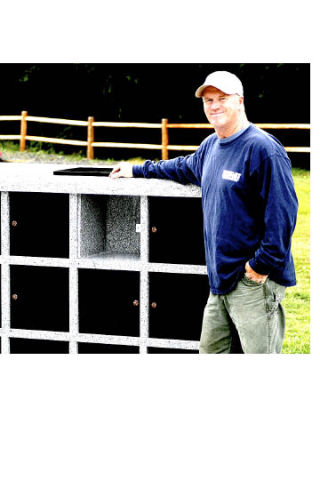Scott deCarteret has made his mark on the Buckley City Cemetery.
Anyone driving past on state Route 410 is bound to notice the American flags and other accouterments he has brought since taking over Jan. 1 as the first full-time caretaker.
And as the grounds have been spruced up under deCarteret’s care, he has responded to the friendly atmosphere found in the small community.
“I’m really happy here and the people that hired me have been very supportive of just about everything I have suggested, so I’ll probably die working here,” he quipped.
Before accepting the Buckley challenge, deCarteret, 49, was one of five maintenance people who cared for the grounds at Auburn’s Mountain View Municipal Cemetery, which has the distinction of being the largest municipal cemetery in the state.
“We had a great boss there,” deCarteret said. “He was our supervisor for a long time and his work ethic and caring attitude rubbed off on all of us. We learned quite a bit from the guy, who didn’t delegate, but rather pitched right in to help us get stuff done.
When his boss retired, deCarteret decided it was time to move on.
“When I accepted the Buckley job, which was offered in a part-time capacity at first, it wasn’t for the money, but because I saw it as a great opportunity to implement some of the creative ideas that I gleaned from my 18 years of experience at Mountain View,” he said.
It was an exciting time for deCarteret, who admits his wife Toni – who shares the responsibility of running the couple’s T-shirt screening business – had to remind him not everyone gets as pumped up about cemetery work.
“She understands my zeal for doing what I do and deals with it, because she knows it is something that makes me happy,” deCarteret said.
He explains that being a modern-day caretaker is more than just mowing the grass around the gravestones.
“On the other end of the spectrum, you are also a part of the grieving process for the people and always want to make it easier for folks, rather than more difficult for them to cope with their loss,” he said.
He strives to provide a personal touch for people going through a tough time.
“Many cemeteries have rather stringent rules about how long the mini-shrines and flowers can be left after the burial,” he said, “but I don’t think it is right to remove things from the gravesite without at least first consulting with the people that placed them there. It is a very emotional time for people.”
Having a full-time caretaker has enabled Buckley to keep in step with modern dictates that municipal cemeteries provide a place for spreading ashes, inurnment niche walls and urn gardens.
During the past year, the city has spent more than $100,000 on four different projects, deCarteret said, with funding coming from the interest generated by an endowment care fund, which has been accumulating money for more than a century. By state law, cities are required to have one of these funds, where a small percentage of each burial or inurnment fee is collected and later used for improvements to the cemetery.
The projects included a matching set of granite niche walls on top of a large cement circle – with a flag pole in the middle – where urns filled with loved one’s ashes can be permanently put to rest. The second project was restoring a 1950 Chevrolet truck for cemetery use, a rig that appeared in the recent Buckley Log Show parade.
The city has furnished another option by assembling a natural, aesthetically-pleasing urn garden named “The Ridge,” where urns can be buried. Also created was an area where ashes can be spread. The latter features a slab of granite intended to memorialize the names of those whose ashes have been spread over the intimate and welcoming setting.
“This is more for the children and grandchildren of the deceased, so they can come and visit the actual site where Grandma or Grandpa’s earthly remains have been sprinkled,” deCarteret said. “Sometimes this helps the survivors get closure on the emotional issue of death and dying.”
He believes that neatness, natural beauty and visibility are the keys to getting people to visit cemeteries or make future arrangements.
“Hollywood hasn’t exactly enhanced the image of cemeteries over the years,” he lamented. “It has always portrayed graveyards as such dark, dreary, depressing places to be.”
One of the jobs of a cemetery caretaker is to erase that perception as much as possible, he said, by keeping the grounds attractive.
The goal, he said, is to “make it a place where people don’t shy away from visiting and make it a more desirable place to set flowers on their deceased relatives’ grave markers.”
To comment on this story, view it on-line at www.courierherald.com. Reach John Leggett at jleggett@courierherald.com or 360-802-8207.



